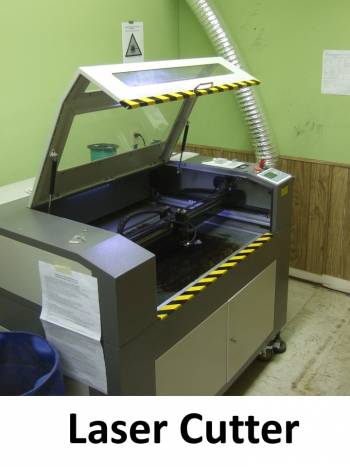This is an old revision of the document!
Table of Contents
LASER CUTTER
Authorized Users
This is a RED level tool, and requires additional training, and is available to members-only
Only authorized users are permitted to use the laser! To become an authorized user, you must be trained by one of the Authorized Trainers.
Operation
Head over to Laser Operations for laser usage and procedures.
Configuration/Calibration Tips
The mechanical stops at the bottom of the Y-axis in their current position are really, really, really easy to crash into. Especially during [TEST] if you're off a bit on material placement. Be warned.
To tighten the second pulley for the X-axis stepper (the larger pulley on the end of the small belt that goes right to the stepper pinion), you need to remove the small timing belt – the set screw for the big pulley is beneath the timing belt (on the edge of the pulley) so you can't see it. Thanks to Ray for pointing this out. To remove the small belt, which is very tight, open the right side top access cover of the cutter. The X stepper is mounted to a black plate which has 4 vertical screws in slots (tension adjuster). Loosen those and the belt slips right off, then the set screw in the big pulley can be tightened.
File Formats
The Lasercut application will directly import Illustrator 7 files (be sure to convert all fonts to outlines and be sure that ruler units are set to mm). Note that if you name your layers “cut” and “engrave”, even if you have more than one layer named “cut” or “engrave”, Lasercut will respect those layers names and maintain your layers when importing.
The Lasercut application will directly import DXF version 12 files and lower. DXF is a CAD format. Some versions of Illustrator will export to this format, as will most CAD programs, and a slew of open-source drawing/painting programs.
PNG and JPG files can be directly imported for engraving only.
Links/Resources
- LaserCut Software related:
- http://grahamwideman.wikispaces.com/Laser cutter -- LaserCut software documentation install issues/workarounds for Leetro Lasercut based machines. (links to some API info for tinkerers)
- http://www.leetro.com/english/down/59.html manual and lasercut 5.3 installer downloads.
- Web Apps & plugins that can help:
- Box Maker: boxmaker.connectionlab.org
- Automatic lasercut notched six-sided box generator. A little primitive, but if you don't have – or want to spend – the time figuring out all the notches for a simple box, this can be pretty nifty. It let's you plug in material thickness and basic notch parameters. It's also a neat way to see how this technique looks if it's a new method for you.
- Box Maker extension for Inkscape. Has versions for both version .48 & .91 - http://www.keppel.demon.co.uk/111000/111000.html
- That link is now dead; here is a zip file from the unofficial source, https://github.com/hellerbarde/inkscape-boxmake
- http://www.makercase.com/ another box maker. This one can do flat edges, finger joints or T-Slot edges!
- Member Margaret showed me another box maker web app: MakeABox.io
- http://climbers.net/sbc/make-laser-cut-case-elastic-clips/ has a laser cut box with CLIPS that can latch the box shut!
- this page has some nice sample projects to cut - a T-Rex to get started with, a basic box demonstrating tabbed box construction, and a teeny led lamp showing curving materials with a series of slits, as well as using captured nuts with screws for joinery.
Links/Resources
- LaserCut Software related:
- http://grahamwideman.wikispaces.com/Laser+cutter+--+LaserCut+software documentation install issues/workarounds for Leetro Lasercut based machines. (links to some API info for tinkerers)
- http://www.leetro.com/english/down/59.html manual and lasercut 5.3 installer downloads.
- Web Apps & plugins that can help:
- Box Maker: boxmaker.connectionlab.org
- Automatic lasercut notched six-sided box generator. A little primitive, but if you don't have – or want to spend – the time figuring out all the notches for a simple box, this can be pretty nifty. It let's you plug in material thickness and basic notch parameters. It's also a neat way to see how this technique looks if it's a new method for you.
- Box Maker extension for Inkscape. Has versions for both version .48 & .91 - http://www.keppel.demon.co.uk/111000/111000.html
- That link is now dead; here is a zip file from the unofficial source, https://github.com/hellerbarde/inkscape-boxmake
- http://www.makercase.com/ another box maker. This one can do flat edges, finger joints or T-Slot edges!
- Member Margaret showed me another box maker web app: MakeABox.io
- http://climbers.net/sbc/make-laser-cut-case-elastic-clips/ has a laser cut box with CLIPS that can latch the box shut!
- https://productrealization.stanford.edu/resources/processes/laser-cutting - this page has some nice sample projects to cut - a T-Rex to get started with, a basic box demonstrating tabbed box construction, and a teeny led lamp showing curving materials with a series of slits, as well as using captured nuts with screws for joinery.

